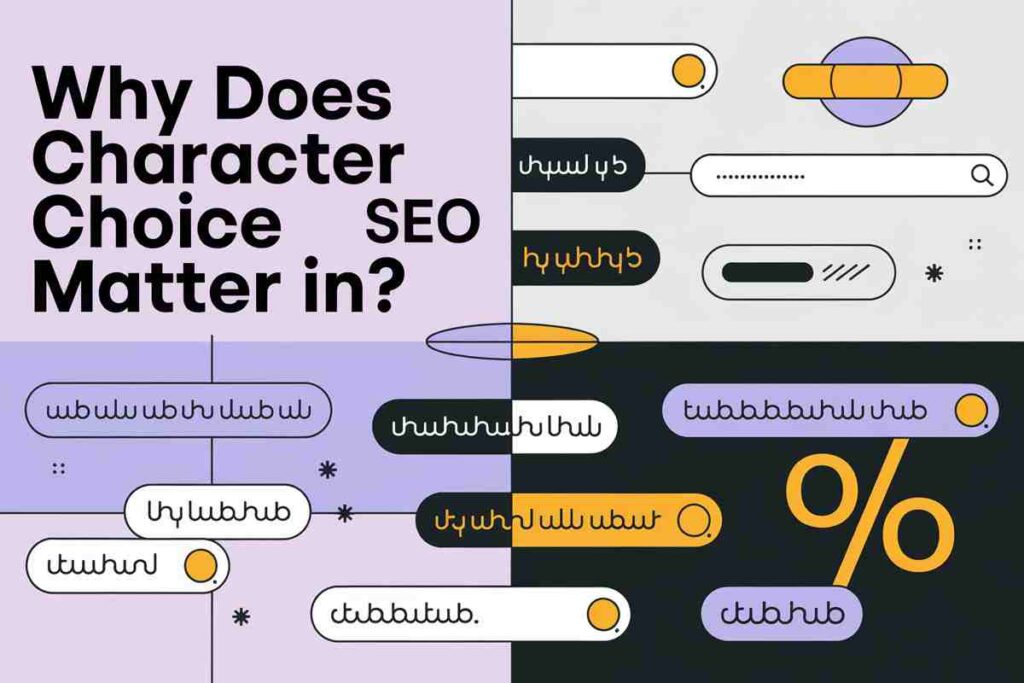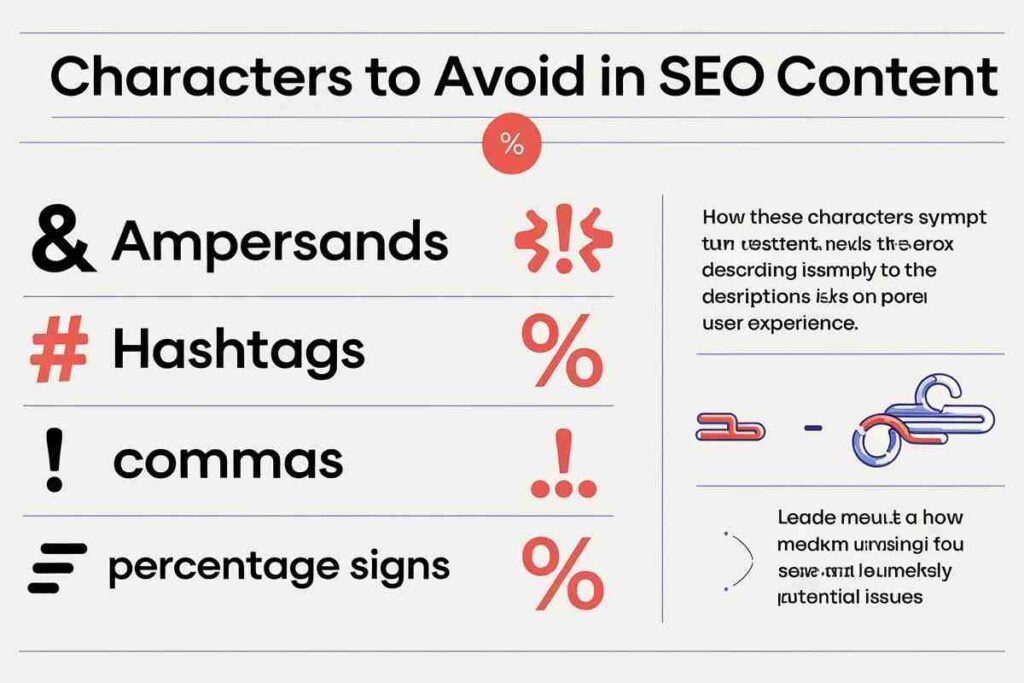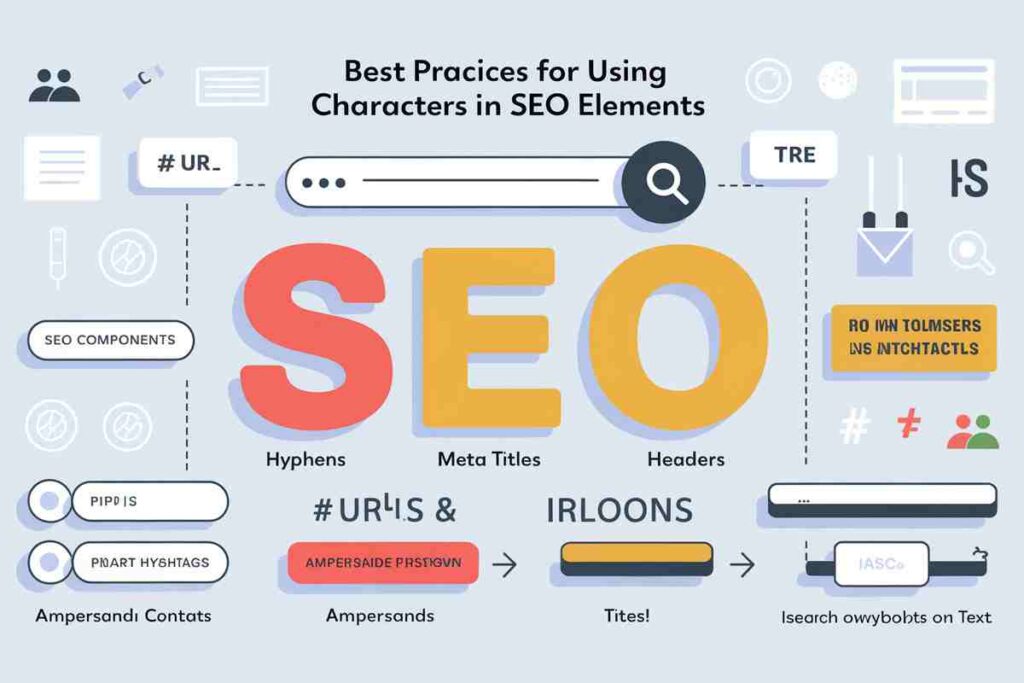When it comes to optimizing for search engines, understanding what characters to use and not use for SEO is essential. Special characters can impact how search engines interpret your content, affecting both visibility and ranking.
In this guide, we’ll cover which characters to embrace, which to avoid, and how they play a role in URLs, meta descriptions, and titles.
Why Does Character Choice Matter in SEO?

Characters you include in your SEO components, such as meta titles and descriptions, URLs, and headers, directly influence how search engines and users perceive your content.
This goes beyond just choosing keywords; it’s about selecting the right punctuation and symbols to communicate clearly with both audiences.
Using the wrong special characters can cause errors in search engine indexing, disrupt user experience, or make content unreadable.
Let’s explore what you need to know about using characters for SEO and how to avoid pitfalls.
Characters to Use in SEO Content
Here are some characters that can enhance readability, clarity, and SEO-friendliness of your content:
Hyphen (-)
The hyphen is one of the most SEO-friendly characters. Use hyphens in URLs to separate words, which makes URLs easier to read for both search engines and users.
For instance, https://example.com/what-characters-to-use-for-seo is clear and easy to interpret.
Use Case: Google favors hyphens over underscores in URLs, as hyphens signal word boundaries to search engines.
Pipe Symbol (|)
The pipe symbol (|) is great for separating phrases in meta titles and descriptions, offering a neat way to structure information.
It’s visually appealing and preferred by many SEOs as a separator in titles, improving click-through rates.
Example: What Characters to Use | SEO Best Practices
Plus Sign (+)
In limited cases, the plus sign can be useful, especially in URLs for denoting “and” or combinations. However, it should be used sparingly since it can confuse users if overused. Google handles plus signs as valid characters in URLs, so they don’t hurt SEO directly.
Brackets ([ ]) or Parentheses (( ))
Brackets or parentheses can make meta titles or descriptions more engaging by highlighting certain words or phrases.
They help emphasize topics or create lists within descriptions, guiding users to relevant information and improving readability.
Example: SEO Tips (2023)
Characters to Avoid in SEO Content

Certain characters can confuse search engines, disrupt URL structures, or even result in broken links. Here are some to avoid:
Ampersand (&)
Using an ampersand in URLs or meta elements is risky. It can cause encoding issues in some contexts, particularly if used in URLs without proper encoding.
Stick to “and” instead, as it’s more universally understood and less likely to cause errors.
Example: Use SEO-and-Content instead of SEO&Content.
Hashtag (#)
A hashtag in a URL creates a fragment identifier, which often leads search engines to disregard the content that follows it, limiting indexing and reducing SEO effectiveness.
This can limit the URL’s ability to be properly indexed and should be used only when absolutely necessary, such as for single-page web applications.
Example: Avoid URLs like https://example.com/seo#guide.
Comma (,)
Commas in URLs can create encoding issues or confuse users. Avoid commas and stick to hyphens for separating words.
Commas can also make content harder to read, especially in meta descriptions or titles where clarity is key.
Percentage (%)
The percentage sign in URLs can cause encoding problems, and it can break URLs if not handled correctly. Instead, rephrase or use words that don’t require special characters.
Example: Replace 50%-discount with 50-percent-discount.
Best Practices for Using Characters in SEO Elements

Using the right characters can impact how well your content performs on search engines. Here’s a breakdown for each component:
Characters in Meta Titles and Descriptions
Meta titles and descriptions are crucial for conveying content relevance. Titles should be under 60 characters, while descriptions should stay within 160 characters. Use the pipe (|) symbol or hyphens (-) to separate phrases and ensure readability.
Special characters in meta descriptions, like brackets or limited use of emojis, can increase engagement when used sparingly. Always run a character counter to ensure meta titles and descriptions stay within the limits for best results.
Characters in URLs
SEO-friendly URLs are short, descriptive, and easy to read. Use hyphens to separate words, avoid spaces, and omit any characters that could confuse or clutter the URL. Avoid underscores as Google prefers hyphens to separate words.
Pro Tip: Use an SEO character counter tool to check URL length and ensure all characters are suitable for SEO.
Characters in Header Tags (H1, H2, H3)
Header tags should be simple and descriptive. Avoid special characters in headers unless they’re necessary for clarity. Characters like commas or ampersands can disrupt readability and may confuse search engines.
Use headers effectively by clearly signaling the main sections of your content without cluttering them with excessive punctuation.
Tools for Checking Character Compatibility
Several tools can help you manage the character limits and choose the right ones for SEO:
- Character Counter: Websites like WordCounter.net or SEO Review Tools Character Counter let you monitor character limits in real-time.
- Meta Description Generator: Tools like Yoast SEO for WordPress can automatically highlight if a description is too long or has issues with characters, helping you to optimize accordingly.
- SEO-Friendly URL Generators: Tools such as Ahrefs and Moz provide insights on URL best practices, including which characters to avoid in URLs.
Conclusion
Understanding what characters to use and not use for SEO can enhance both user experience and search engine readability. Stick with safe characters like hyphens and pipes, which improve clarity and organization in titles, URLs, and headers.
Avoid characters that lead to encoding issues or disrupt readability, like ampersands, hashtags, and percentages.By following these best practices, you ensure that your content is SEO-friendly, easy to navigate, and appealing to both search engines and users.
Don’t forget to use tools to double-check character limits and SEO formatting, and remember that simplicity and clarity should guide your character choices.
FAQs
What characters should I avoid in SEO?
Avoid using ampersands (&), hashtags (#), commas (,), percentage signs (%), and exclamation marks (!), as they can cause indexing issues or affect readability.
Can I use emojis for SEO?
Emojis are not recommended for SEO as search engines may not interpret them correctly, potentially affecting content display.
What is the best character for SEO-friendly URLs?
Hyphens (-) are the best choice for SEO-friendly URLs as they separate words clearly, making them easier for search engines to read.
Is it okay to use an ampersand in SEO titles?
Using an ampersand (&) in titles is fine for saving space, but don’t overuse it, as it can appear unprofessional.
Can I use parentheses in meta descriptions?
Yes, parentheses are useful in meta descriptions for adding clarity, but use them sparingly to avoid cluttering the content.
Should I use underscores or hyphens in URLs?
Always use hyphens (-) in URLs instead of underscores (_) as search engines interpret hyphens as word separators.
Do special characters impact my search rankings?
Yes, certain special characters can disrupt readability and indexing, which may affect your SEO performance.
How can I test the effectiveness of special characters in SEO?
You can A/B test different characters in titles and meta descriptions to see how they impact click-through rates and user engagement.



